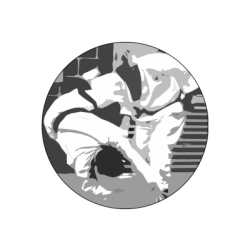Dojo Etiquette
Good Dojo etiquette is essential for the smooth running of the class and also promotes respect and discipline.
Students must always arrive, dressed and ready to train, at least 5 minutes before the class starts. If you are unavoidably late for the ‘bow-on’:
- Bow to enter the Dojo.
- Kneel at the Dojo entrance and recite the Dojo-kun in your mind.
- Perform the ‘bow-on’ sequence.
- Stand, then bow (Tachi-rei or Standing Bow) towards the Sensei.
- Wait for the Sensei to acknowledge your presence before joining the class.
Always bow upon:
- Entering and leaving the Dojo.
- Before and after addressing your Sensei, or if your Sensei is addressing you.
- Before and after performing various techniques with each other.
If the Sensei is not present, the Sempai (the most senior of the class) will start the class. All students must follow the Sempai as though he were the Sensei.
You must inform your Sensei/Sempai of any kind of medical condition or injury – a student may be advised that a doctor’s advice may be required prior to further training.
During the session, students must work with an attitude of seriousness and complete concentration. Laughing and talking cannot be permitted. Silence and seriousness during the session are the two rules that must be followed if a high level of training is to be sustained.
Unless training has commenced, all students must bow to Yudansha upon their arrival at the Dojo.
Rapid movement is an essential part of the training, even as it pertains to lining up on command. This habit of moving quickly, without wasted effort, will also help keep the class working smoothly.
When not training (for example, during breaks) students must sit cross-legged against the wall in the Shimoza (lower-house) area of the Dojo, or in designated resting areas.
You must always wear a clean and pressed white Gi. Badges (association, club) must be worn on the left-side of your Gi (chest, arm). Other badges (for example country representation badges) may be worn on the right sleeve (these are only issued and supplied by your Sensei).
Only females and students with special medical conditions may be permitted to wear a t-shirt (white) under their Gi top.
No student should leave the Dojo during the session unless he has prior permission from a Sensei or Sempai to do so – this is for reasons of good etiquette as well as Health and Safety.
On the command of ‘Seiretsu’ students must line-up quickly and quietly in the proper grade or rank order in the Kiritsu (informal attention) position (Musubi-dachi). You must not pass in front of higher graded ranks to do so; filter in from the rear and side of your own line.
If a student must stop work for any reason, then he must obtain permission from his Sensei.
All students must reply ‘Hai-Sensei’ after a command has been given. During training, if you are approached by a Sensei for any reason (i.e. adjusting your technique) you must acknowledge the Sensei with ‘Hai-Sensei’.
Each student must report when temporarily discontinuing lessons – this is good etiquette.
If at any time during training the student requires to adjust his Obi or Gi, he must go down on one knee to do the adjustment. On serious adjustments the student may require to leave the ranks to go to the side of the Dojo and again drop onto one knee for the adjustments.
Seniority system: All students must be aware that a higher ranked member to you is your senior and must be obeyed as such while in the Dojo. Brown-belts and lower graded Black-belts must be referred to as Sempai at all times. They are the Dojo ‘Police Force’ and are responsible for the discipline in the Dojo, so ‘ongoing’ knowledge of the Dojo rules is of paramount importance – every Sempai must have a copy of the Dojo rules ‘to hand’. Young, as well as older, Sempai MUST show a good example. Examples are always followed.
Black-belts 3rd Dan and above and any Black-belt who is teaching is referred to as Sensei at all times. During practice no student should go directly to the Sensei without first attempting to gain the necessary knowledge from the next grade up. Each student, however, should make the necessary endeavours to learn the answers from continued practise and observations. The Sensei should be consulted ONLY as a final option.
The motto of the Dojo – Practise hard in order to master the techniques of true Karate-do.
Finger and toe-nails are to be kept short and clean.
No drinking, eating, smoking and no jewellery to be worn in the Dojo. Any jewellery (for example a ring) that is difficult or impossible to remove MUST be safely covered.
A student who has undergone surgery or who suffers from any kind of serious medical condition or injury will not be permitted into Jiyu-gumite or any form of stamina training. Your Sensei, as well as your working partner, must also be made aware of any condition.
Respect and revere your parents and elders; respect other people. Respect property and all life. Respect yourself.
A Sensei is always a Sensei, not just while he wears a Gi. He must be respected inside, as well as outside the Dojo. If he is also your friend, do not take advantage of his friendship.
Never use Karate outside of the Dojo, unless for self-defence. Understand the concepts of Karate-ni-Sentenashi.






